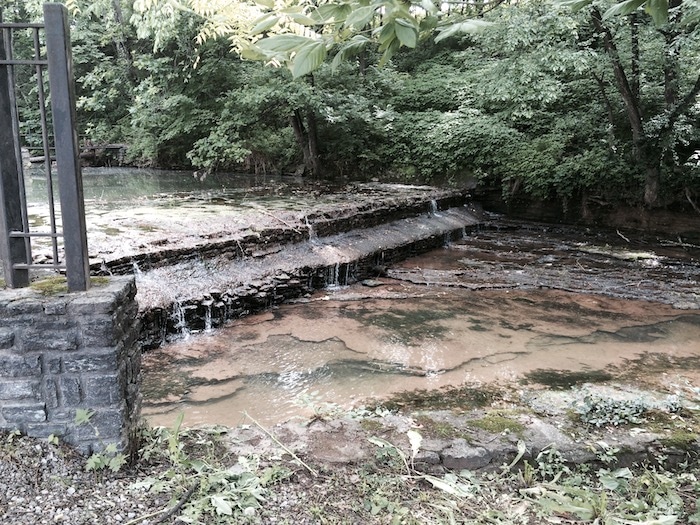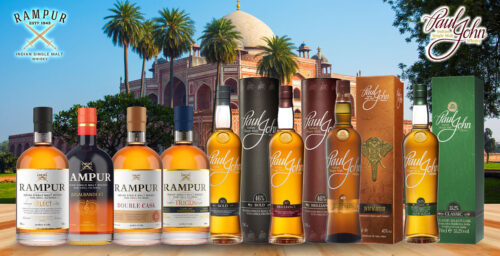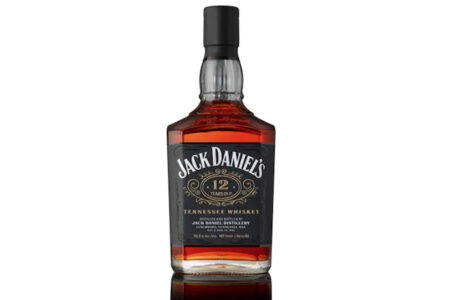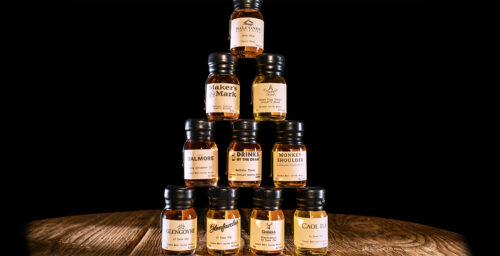Editor’s Note: This is the fourth in a nine part series chronicling the life of James Crow, an extremely important figure in the history of American whiskey. A chemist originally from Scotland, he is credited by some as having invented the sour mash process. Watch this time slot on Thursdays (11am Pacific Time) for the other articles.
When Crow arrived in America, the distilling industry was developing along different grain mash vectors and adopting patented wooden steam stills. Rye, malted rye and corn dominated the mash bills on the eastern maritime States, while west of the Appalachians, high corn mashes dominated production.
To mitigate the stickiness of rye and thickness in corn mashes, wooden chambered steam-powered stills became popular as they prevented scalding. These new wooded stills were much cheaper in construction and materials, enabling distillers to substitute wood for expensive imported copper, that also incurred a punitive 25% Government tariff. The speed of steam heating by an external boiler was able to generate higher throughput volumes with scalding. Their novel semi-continuous batch configuration expeditiously allowed more charges with less downtime for cleaning. This lowered the manufacturing cost per gallon significantly – but paid a quality price as it’s spirit was inferior to all-copper apparatuses.
While Crow spurned America’s new wood stills he needed to harness Kentucky’s climate that adversely affected fermentation, exposing Crow to the little-understood acidification method known as sour mashing. Crow also found most American casks were smaller to Scotland’s standard hogsheads, butts and puncheons for storing whiskey. Transporting whiskey in America entailed long distances and often over treacherous conditions, with limited space in flatboats and wagon drays, necessitated coopers reduce cask capacity and weight to smaller more robust barrels and kegs.

By the late 18th century, east coast distillers had discovered the benefits of charred cask interiors to improve flavor by vulcanizing residual bitter sap contaminants in new oak staves not adequately seasoned. The charcoal membrane from the charring filtered fusel oils endemic in corn distillates, improving the finished flavor of the whiskey. All the elements that constitute American (straight) whiskey coalesced before 1820, and Crow would harness these emergent trends to formulate the process parameters to make sour mash whiskey to an exemplary standard, ergo modern bourbon whiskey.
On June 21st, 1821, the word ‘bourbon’ whiskey first appeared in print when Paris Kentucky’s Western Citizen advertised Stout and Adams of Maysville, ‘Bourbon Whiskey by the barrel and keg.’ By 1840 the vernacular term was gaining State-wide acceptance, yet Crow never called his whiskey Bourbon, nor did he describe it as Western whiskey, another popular name at the time. Within decades, the bourbon moniker gained currency outside Kentucky, and by the late 1840s, the whiskey trade began bottling the bourbon whiskey brands in New York and Boston.
Corn’s high-yielding cultivation in the Ohio Valley and Midwest from the late 18th century monopolized grain bills with over 80% of the mash. American consumption of spirits was changing too. By 1823, the once pervasive rum had declined to less than twenty per cent of public consumption, and whiskey had supplanted it as cheaper and easier liquor to obtain. Whiskey was in the ascendency in both North America and Britain. Other alcoholic drinks like beer and even cider were perishable beverages with limited appeal due to their shorter shelf life.
The last Government audit of breweries in 1817 found only 113 operated in America, versus 7,759 stills were active. By the time Crow arrived in Kentucky, only a handful of breweries had conducted business in the State. Curiously, Kentucky’s first brewery was started by John Nancarrow in 1789 at Scott’s Crossing on the Kentucky River in Woodford County. Four years later Nancarrow moved production to nearby Lexington, and by the time Crow arrived at Glenn’s Creek, it had closed.
In Kentucky’s 1850 Census only 35 brewers were recorded as residing in the State, whereas 49 inhabitants described themselves as distillers, highlighting only a few distilleries and even fewer breweries had the commercial acumen and size to fund the employment of a skilled tradesman.
When Crow arrived in America, unlike the heavily regulated Britain, the Federal Government exercised no control over distilleries nor levied any taxes or licenses. Some States had local ordinances taxing the retail sale of liquor. US Treasury records on licensed stills and production ceased in December 1817, and by 1823 it is estimated as many as 20,000 were in use in the states and territories. The next survey, the 1840 National Census reported 9,657 distilleries producing over 36.3 million proof gallons of ardent spirits, and about 400 breweries.
As a historical aside, Crow did not have to deal with recalibrations when Britain overhauled its system of weights and measures. In June 1824, the year after Crow arrived in America, the British Parliament changed its weights and measures to their new Imperial system leaving America unchanged with the old English or Elizabethan Exchequer standard in use today.
By the 1820s, American distilling practices and plant diverged into regional complexities with variations in grain mashes, fermentation methods and different distilling technologies. As an example, the Ways & Means Committee evaluating excise tax in 1816 classified stills under four classes: 1. stills of the old plan (pot/common); 2. Stills not old but best modern improvements (patented formats); 3. Boiler, or distillery apparatus worked by the aid of steam; and 4. Other modern contrivances, log, rectifying vats, etc., with further qualifications based on boilers and still capacities, including some shallow stills.
However, it is possible to capture a picture on the general conditions and popular approaches to whiskey distilling, especially in the fledgling Kentucky bourbon industry. This will make for a useful comparison to Crow’s methods in a later analysis. Distilling whiskey involves endless possible computations: agronomy and growing seasons, changing grain varieties, grinding and malting specifications, variations in mashing temperatures, grains bill recipes, length of fermentation; yeast strains; distillery plant, etc. Just as every cask is nominally different, the interpolations from grain to distillate becomes an open polynomial equation.
Fortunately, production equipment and biological processes generally follow shared conventions, so it is possible to summarize the salient production practices to describe the state of Kentucky whiskey distilling in the 1820s,
Distillery construction: Large agricultural landowners and entrepreneurial investors were able to capitalize on whiskey’ potential by building small commercial-scale distilleries with the modern appurtenances, machinery and the latest safety features. By the 1820s, these new distilleries constructed of stone and brick featured fireproof rooms, with spacious interiors allowed the heat to rise and sunlight to enter through generous windows with shutters to control airflow. Ventilation was essential to remove ethanol vapor, furnace smoke, CO2 from the fermentation and to control interior temperatures to optimise biological conditions.
In winter, stoves were installed to heat frigid still houses and mash rooms, along with kerosene lumination and candle lighting, so naked flames were constant threats and caused numerous distillery fires and destructive conflagrations. Sensible floor inclines and gravity fed water permitted efficient water flows for mashing, cleaning and condensing saving labor, time and cost of pumps. Constant and reliable, clean cold water was essential for a distillery ‘s viability.
Limestone water: Kentucky’s karst limestone deposits filter clean, hard calcium carbonate water and have long been credited as a ‘budding’ asset in supplying mineral nutrients to stimulate yeast growth to catalyze grain sugars into ethyl alcohol. Distillers of old, celebrated Woodford County’s mineral-rich water, describing the pristine springs as tasting ‘sweet and clean’, in other words, fresh and delectable as alkaline water, rich in dissolved limestone, that tastes slightly sweet.
Local distillers along Glenn’s Creek in the 19th century, celebrated their natural springs, declaring ‘the water is purer from Woodford County than almost any other county in the State.’ Only water below 60F was sufficiently chilled to run through the flake stand for condensing, so colder subterranean water was preferred, compared to the variable temperatures that affect surface water from streams and reservoirs.
Instruments: By the early 19th century, measurement instruments were in use by earnest American distillers and recommended in production manuals to monitor essential parts of the whiskey-making processes, such as Daniel Fahrenheit’s 1715 mercury thermometer for determining temperature, John Richardson’s saccharometer for gravity, and the barometer to monitor the atmospheric weather conditions. Since August 1790, the Government measured proof for the excise with the Dicas hydrometer, an essential tool to gauge proof levels at distillation, entry into the barrel and setting accurate prices for dealers and retailers.
Grain bills: By 1840, Kentucky was the second-largest corn-producing State behind Tennessee. It fell to fourth place in 1850 with 58,672,591 bushels of corn, 415,071 ryes, and barley at 95,343 bushels. By the 1820s, Kentucky distillers had a preference for yellow corn, whereas their southern neighbors in Tennessee preferred white corn. Kentucky’s average yield per acre of corn in the 1840s was 35 bushels, with small grains, such as rye and barley averaging 12 bushels per acre.
The primary purposes of cereal cultivation were grain sales to millers and dealers, household consumption, feed livestock, and seed reserves to plant the following season’s crop. Surplus grain was despatched for distillation, thereby avoiding spoilage by mould and vermin, converting the bulk storage of a fungible into a long term value-added product. The farmer-distillers’ annual whiskey production was a consequence of seasonal acreage under cultivation and their surfeit.
Barley cultivation along the east coast proved less productive and was sparingly used for malting, compared with rye, which readily substituted malt barley for malted rye. Commercial distillers recommended malt ratios of 10% to 20% barley malt or rye malt to ensure optimum diastatic power for amylase enzymes to convert starches to sugars. Where barley cultivation prospered, the 6-row variety, planted as an early Colonial landrace, proved better suited to America’s cold winter climate, than the traditional English 2-row barley.
Even oats were reported to be found in some mash bills, as it was Kentucky’s second most popular cereal by 1850, and represented 12% of all grain cultivation. The different grain mashes led to the marketing of regional styles with discernible sensory characteristics, such as in Western Pennsylvania’s mostly all-rye Monongahela whiskey, Maryland ryes with a higher ratio of corn blended with rectified whiskey, and Western whiskey mashed with corn dominant grain bills.
Malting & grinding: No independent maltsters operated in Kentucky when Crow arrived, only a handful of breweries with their small malting flours served a few of the larger towns. Malting was labour intensive from sprouting green grain to turning and drying; for distillers, buying malted grain came at a premium price for the extra labor, process loss and fuel. Distillery maltings used the most basic methods of floor germination and drying in barns or on the open terraces cured on tin sheets. Similar to distilling, the malting season was limited to colder months.
Where barley could not be grown or procured, other small grains, especially rye, were malted to produce enzymes for metabolizing starch into sugar. Grist mills were the first mechanical enterprises erected in the Commonwealth, and Kentucky millers benefited from the previous century and a half of grinding the different grains for the best mash to distil whiskey. Corn needed grinding to fine flour for cooking in scalded water, while rye was a slightly coarser meal, and malt was best chopped or bruised into a less floury consistency to produce the best beer for distilling.
The fineness of the mashed corn and the gumminess of rye would not allow for easy filtering and draining to extract wort before fermentation, necessitating the American practice of ‘distilling on the grain’. Since colonial times Government regulations required the branding of flour barrel heads to designate the grain type, grind and weight; this system was later adopted to codify whiskey barrels and the etmology of branding.
Mashing grain: Since the 17th century, American brewers and distillers had learnt how to obtain good alcoholic yields from the different grains using proficient mashing procedures to liberate starches, ensure efficient diastatic conversions and the selection of yeast strains for vigorous fermentations. The scale of production of a distillery’s daily output started in the mash room with the number and capacities of tubs.
Mash tubs or old casks made from barrels, hogsheads or coopered into mash vessels could hold about a bushel of grain per mash. Mashing started with buckets of hot slops (backset), and boiling water poured over the cornmeal, then hand-stirred with mash sticks. Coldwater was added to cool the corn mash, and after that the small grains where added at lower temperatures. Mashing required regular stirring to prevent balling, this simple tedious act using wooden rakes or oars accorded the whiskey the attribution ‘hand-made’.
A 63-gallon hogshead cask took a bushel of corn, plus small grain, and used over 40 gallons of slops and water to mash. During mashing, distillers could add salt and a shovel full of hot coals (charcoal) to moderate malodorous compounds. A tub was usually the size of two hogsheads, and often the mash tub doubled as the fermenting tub. A distillery’s daily mash volume matched the still’s capacity, and the frequency of charges the distiller was able to work the still. As production increased to dozens of bushels, tanks and vats replaced tubs, mechanical stirrers worked the larger volumes of mash, with pumps and pipes transferring the liquids to fermenters and stills.
Yeast & fermentation: Having a durable yeast strain that fermented agreeable flavors and made good strength alcoholic beer was the commercial imperative. The lack of a local ‘brewer’s sweet yeast’ and access to imported compressed yeast stock, required most distillers to make their own naturally cultivated strains of Saccharomyces cerevisiae. The local terroir introduced other microflora into the yeast culture, and through careful selection and propagation led to distilleries developing and maintaining their house jug yeasts to create a beer and distillate with the desired flavor characteristics and alcoholic yield.
Kentucky’s hot, humid climate promoted bacterial infections; however, when judiciously controlled, as Crow was to master, they produced a short lactic fermentation, adding new flavor compounds to enhance the beer. The higher alkalinity of Kentucky’s limestone-rich water was not the most conducive environment for yeast to work actively over the several days of fermentation. To create a more hospitable place for the yeast to thrive in the mineral-rich water, distillers acidified their mash by lowering the pH, hence the taste of the sour mash is due to its acidity. Until the latter part of the 19th century, many Kentucky distillers were resistant to the sour mash method preferring the traditional and more straightforward sweet mash method.
Sour and sweet mash methods: While most Tennessee distillers used sour mash by the 1820s, only a minority of Kentucky distillers had learnt about backset, or sour mash to manage the acidity of their ferments. Most preferred the sweet mash method using fresh batches of yeast to ferment each batch of mash. Acidifying the wash was a method some Highland distillers employed using spent pot ale to inoculate the wort and lower the pH. It allowed the enzymes to continue to catalyze sugars for the yeast to metabolize the liquor sugars into alcohol. The pot ale containing hydrolyzed dead yeast cells provides extra nitrogen and nutrients for the yeast to feed on, and the organic acids lowered the pH.
In Jamaica, British rum distillers discovered acidification was an essential mechanism to control fermentation in the hostile tropical conditions. Spent distillers wash or lees was called dunder and added to help and promote the fermentation. Jamaican distilleries discovered by storing dunder in putrefying pits it continued to decompose further as the bacteria metabolized lactic acid, increasing the acidity to the dunder.
Since the 1700s, the most popular recipes used one-third dunder, one-third water, and one-third scummings from boiled down sugar syrup and molasses, then let the wild and endemic cane yeasts set to work. Many of the West Indies distillers owned property and became involved in colonial rum distilling in North America introducing acidification treatments from South Carolina to New England. It was adopted by distillers when whiskey started to replace rum in the new Republic.
In Pennsylvania, Michael Krafft wrote in 1804, ‘The plan of cooling off the liquid part of the returns, or what is termed pot ale (spent distillers wash used as backset), has advantages, it serves the purpose of producing a powerful and rapid fermentation’. Crow played an instrumental role in calibrating the numerous sour mash methods into optimal doses and temperatures, adjust the acidity to inhibit bacterial infections, inoculate and optimize the yeast’s catalyzing potential and ensure flavor continuity batch to batch.
In November 1823, twenty miles away from Glenn’s Creek, the Lexington Gazette published two mashing recipes, a sweet mash making two gallons per bushel, and sour mash generating up to 2½ or 3 gallons, with over 30% setback or ‘still slops’. The merits of sour mash were gaining acceptance to traditional sweet mash in Woodford County.
Distilling terms can be notoriously confusing as different descriptors for the same function vary between spirit categories, countries and even distilleries. In Britain, a fermenter is called a washback, heads called foreshots, and sour mash has spawned many colorful colloquial descriptors in America, such as backset, slops, spent beer, used pot ale, swill, lees, stillage, feed mash, and setback.
In Scotch distilling, pot ale refers to the spent wash or residual liquor (about 1% ABV) left after the distilling of low wines. The residuum from the second distilling of high wines in Britain are called feints, and redistilled in the next charge of low wines; the final waste removed from distilling of high wines spirit still is called spent lees. Backset used for the sour mash, whether spent wash or spent lees are all low in pH.
Fuel & furnace: Sensible management of controlling heat efficiently and the type of fuel impacts on the whiskey’s quality and cost. The Industrial Revolution led to more proficient and safer furnace constructions for boilers and heating stills. These engineering improvements advanced the distribution and retention of heat by regulating airflow with metal shutters and flues, taller and sturdier chimney stacks to remove smoke and dangerous embers, and iron grates for clearing the ash pits.
Another benefit was fuel efficiency as large quantities of cord timber were consumed to run a distillery; however, a more efficient fuel source was about to enter the local industry. In 1820, Kentucky’s first coal mine opened and within twenty-five years Kentucky shipped over 100,000 Imperial tons. Rail would eventually make Kentucky coal more economical, more thermally efficient, cleaner and compact for storage.
Still apparatuses: A US Treasury audit in December 1816, recognized a variety of still types based on their cubic capacity. Of the 37,880 stills reported, seventy-five per cent were less than one hundred-gallon capacity. Another 650 used steam boilers, evidencing the popularity of patent American wooden stills in ‘great variety of construction’. These steam-heated wooden patent stills were triple-chambered compartments, with a pipe connecting to a doubler still (also called Bourbon steam stills); others were simple log still frames, rectifying tanks and other contrivances.
The majority of distillation apparatuses were conventional pots, ‘old plan’ or ‘old ways’ small-scale copper alembics used by homestead farmer-distillers. Larger versions of these stills used chains or scrapers operated by hand, later mechanically, to stop grain particles adhering to the still interior during the heating stage, thus preventing scalding and leaving the spirit with a burnt or empyreumatic taste. Still bases were often greased with beef tallow, bacon or soap to avoid burning the distillate inside the direct-fire heated stills. Pots stills produced more flavoursome and wholesome distillate, but were far less efficient in fuel, labor and output than the new multi-chambered wooded stills.
They also needed thorough cleaning between charges, and risked scaling and foaming through the pipe to foul the worm. Distillers could control this threat by the addition of charcoal or soap. The pot still’s copper improved the spirit’s wholesomeness by removing sulphates, where the wooden chambered steam stills meant less copper contact and their semi-continuous process also prevented the separation of fusel oils from the final distillate. Rectifiers columns mounted on pot stills for fractional distilling, and large bourbon beer columns did not enter service until years after Civil War.
Distilling proofs: The common pot stills of the ‘old plan’ required batch distilling in two separate distillations. The first distillation or singling run produced low wines averaging around 50 Proof or 25% ABV (ranged between 22% to 32% ABV). The second or doubling run produced high wines averaging 125 proof or 63% ABV (usually 52% up to 77% ABV). The degree the proof collected in the receiver or cistern was also affected by beer’s fermented strength usually 14 proof (5 – 10% ABV), the still design and how the distiller worked it, as well as where the distiller made the cut.
Since 1790, the Government established the proof gallon for tax and trade sales (49.9 – 51.9%), known as ‘first proof’. There were five higher proof thresholds and incremental tax levels, with ‘sixth proof’ the highest strength at over 160 proof (+80% ABV). Whiskey entered into the barrel at 52 to 55% ABV in the 1820s, was a legacy of previous excise tax regimes and a distilling limitation of the older and less efficient apparatuses, especially the early ‘Bourbon steam still’ that distilled spirits around proof strength.
Barrels: Before the 1820s the standard cask size for distillers was either the traditional hogshead, about 63 to 65 gallons (250 litres) and for imported wine, puncheons of 110 gallons (or 415 litres). Hogsheads were well suited as mash tubs as they filled stills of a corresponding capacity with a bushel of mashed grain. As farming shifted to more remote areas, more robust and portable size casks became a necessity. When loaded onto different modes of transport, smaller casks were more efficiently and safely stored on riverboats, wagons and later railcars.
By the late 1830s, the common size for a whiskey barrel was evolving from 31 gallons to 40 gallons (33-inch stave). After the Civil War, it increased to 42 gallons, and in the 1880s, the average size was 43 gallons (35-inch stave). By 1900, it grew to 48 gallons, and in 1943 the Government mandated the standard barrel of 53 gallons with 37½-inch staves. By the 1830s, distillers used barrel charring, a practice established and advocated by east coast whiskey distillers’ decades earlier – known as ‘sweeten the cask’ by ‘scalding with (hot) ash’, or ‘setting ablaze’ and ‘well burnt inside’.
By 1850, Kentucky had 1,027 coopers supplying a variety of slack and tight casks for the export of grain, meat and whiskey. The modest production volumes of Pepper’s distillery did not require a cooperage. Large cooperages in Louisville and one in nearby Frankfort owned by Alexander Macklin who also had a farm on Glenn’s Creek, supplied the barrels. His Frankfort cooperage was originally built to ship flour from his mill, and pork from his slaughterhouse.
In part 5 next week we take a look at Woodford County, Kentucky and the whiskey economy during Crow’s time there.








